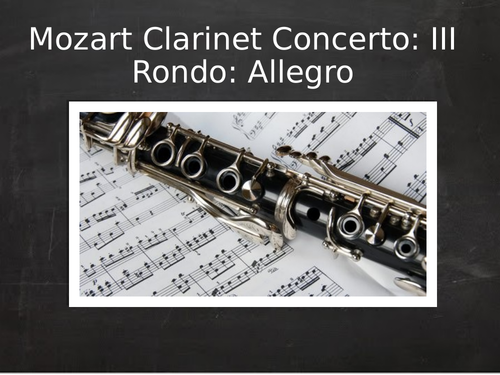

A full walk-through of the new AQA set work (Mozart Clarinet Concerto 3rd movement rondo) with clear, animated score analysis with a mixture of analysis questions for students and some teacher-led analysis.
Contextual overview and consolidation questions included. Colour-coded annotations according to musical element. Split into two PowerPoints because it’s such a big file (sorry!).
Would recommend combining with a glossary of analytical terms for students with weaker theory knowledge, and a blank score.
Something went wrong, please try again later.
Just downloaded - a bargain at £1.50. Thanks for all your efforts to do this - it's a great resource. <br /> AQA have their terminology wrong... the chord at bar 110 is an Augmented 6th not a Neapolitan.
Thank you for a well presented and pupil friendly PowerPoint resource with many valuable points. The analysis of the structure of this movement is however perhaps a little shaky as it isn't actually a rondo but uses instead Mozart's rather unusual version of sonata rondo which he incorporated into many of his late concertos: A B (exposition) A C (development) B A (recapitulation) Coda. The structure of the movement is therefore probably best analysed as follows : Bar 1 first subject group (refrain); Bar 57 first episode; Bar 114 first subject group (refrain); Bar 137 second episode and some development; Bar 188 third episode ... reprise of the first episode; Bar 247 first subject group (refrain); Bar 301 coda. Oh and the first movement of the concerto is also a hybrid structure, again favoured by Mozart in his later concertos. So, it's a mixture of the Baroque ritornello approach and Classical sonata form. Bar 1 orchestral ritornello; Bar 57 solo exposition; Bar 154 orchestral ritornello; Bar 172 development; Bar 227 orchestral ritornello; Bar 251 recapitulation; Bar 343 orchestral ritornello. Perhaps more than most Classical and early Romantic composers, Mozart regarded the concerto as a distinctive genre, and he generally approached it quite differently to his symphonic work.
Report this resourceto let us know if it violates our terms and conditions.
Our customer service team will review your report and will be in touch.
